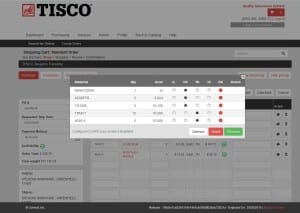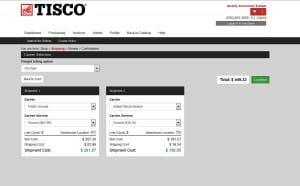Share
Author
Sam Bayer
Share
Shipping, Not Shopping, in B2B
In one of my previous posts entitled “5 Lessons Learned from B2B Integrations of SAP® with Magento and hybris” I made the point that the “consumerization-of-B2B-eCommerce” camp may be going a bit overboard with their emphasis on providing a “merchandising” sensibility to the industrial buyer’s “purchasing” requirements. Today’s post is about focusing on what’s really important to your B2B ecommerce business; the ability to provide accurate product availability and total costs (including shipping) to your customers in real time on your website.
To begin with, it’s important to acknowledge that once again, Amazon has set the benchmark in the eCommerce industry. The success of their industry disrupting Amazon Prime program shows us that free shipping can ultimately become a game changer. The Prime program produces greater customer loyalty and increased gross revenue according to this 2011 report. The Amazon Prime program continues to be a…well uh, prime… contributor to Amazon’s growth and added 10 million new subscribers during the 2014 Christmas shopping season.
But it’s a scary program to implement for the conservative thinkers of the business world. The math just doesn’t seem to add up. You can just hear the chorus in unison, “Free shipping? No way. You know what that’s going to do to my bottom line?”
The math never does seem to add up with disruptive innovations…initially.
If Henry Ford would have delivered only what his customers were asking for he would have simply built a faster horse drawn carriage. Steve Jobs would have built a better Sony Walkman instead of delivering the industry defining iPod and iTunes.
“Besides, our B2B customers”, innovation leery B2B suppliers proclaim, “aren’t screaming “Free shipping” they’re just begging for cheaper rates and more visibility, control and reliability of our shipments”.
faster buggy. faster buggy. faster buggy.
Just sayin’.
Anyhow, while the free shipping “disruptive innovation” may be off the table for now, we at least have to give customers what they’re asking for today. That’s what today’s blog post is about. What Corevist has done to help our clients who want to become more transparent, and perhaps a bit easier to do business with, in their complicated omnichannel world of multiple warehouses and many shipping options.
To begin with, it’s important to reiterate the expectations of your B2B eCommerce website users. Fundamentally, they come to your website with only three questions and one presumption in mind:
- Do you carry (or are you able to get) the product that I need?
- Is it available within the time-frame that I require?
- How much is my total cost (including shipping)?
The presumption is that you are telling them the whole truth and nothing but the truth. They are banking on the delivery dates and costs that you promise them on the website. Miss a delivery, or adjust the cost after the fact, and you’ve broken the trust. They can, and will, go elsewhere as soon as it’s practical for them to do so.
Here is how to answer your customer’s three questions:
Question #1 (product) should be answered by your catalog. Make it easy to find the right product and customers will gladly move on to the checkout process. I’m not going to say anything more about that today other than that’s where the “consumerization of B2B” purveyors should have a field day.
Question #2 (availability) is easy to answer if you only have one warehouse, or if the requested product is available in your customer’s “facing plant”. If you have multiple warehouses and the requested product isn’t in the facing plant, things get more complicated, especially since you never want to turn a customer away. Under those circumstances, the availability question can only be answered by interrogating all of your warehouses and allowing SAP® to exercise it’s Available to Promise capability in real time on the website. Almost all of our clients have multiple warehouses to check. This gets really challenging, and increases in importance, in the omnichannel world where web orders are competing with phone/fax/email and EDI orders for the same inventory. Remember, your customers presume that you are telling the whole truth. Here is what they want to know:
- If it’s not available today, when can I get it?
- If I can only get some today, and more at some future date, let me know how many I can buy today and at what future date I can get the rest.
- Can I get it from one of your other warehouses?
- Can I get some of my order from one warehouse and the rest from another?
- Can I combine everything in my order to ship from one of your warehouses?
- If you can’t promise me a delivery and have to put it on backorder, let me know right away.
- If I chose to buy a backordered item, please let me know as soon as it’s available to ship. Don’t make me call you to check on it.
Here is a screenshot of what we’re about to put into production at one of our clients. It puts getting all of the answers (in real time from SAP®), and making all of the shipment choices, directly in the hands of the website user:
Question #3 (cost) is answered by combining the price that SAP® calculates for that particular order (with all of the contract pricing conditions/discounts considered) with the cost of the shipping options the customer selects. We’ve integrated our service with that of a service from our partner ERP-IS called ShipERP in order to provide real time costs from all allowed carriers for the web user to select from…across all warehouses that the order may span. You can see what that looks like for a shipment that will come from two different warehouses in this screenshot:
We just conducted a Customer Focus Group on these Plant and Carrier Selection processes and they were met with unanimous approval. Customers loved the control they were getting over the cost and timing of their shipments.
They got what they asked for (faster buggy) and were overjoyed to receive it.
Later that day, I went online to Amazon and ordered 3 different books from 2 different suppliers and they all arrived 2 days later without my having to pay any shipping charges. By the way, come to find out that Amazon has 67 distribution centers in the US. Who knew and frankly who cares? Not me.
Until our clients find a way to disrupt their respective industries with their own “Prime” shipping programs, our job is to partner with SAP® and ERP-IS to give our mutual client’s customers totally visibility and control of the timing and costs of their B2B eCommerce shipments…in real time, 24×7.
Sam










